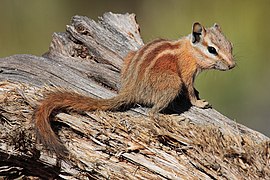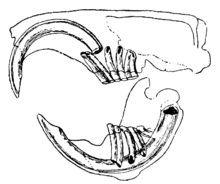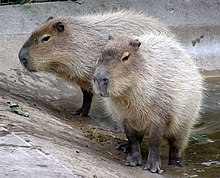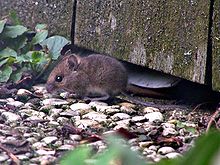啮齿目
| 嚙齒目 化石时期:早古新世 - 現今 PreЄ Є O S D C P T J K Pg N | |
|---|---|
 | |
水豚,現存最大的嚙齒動物 | |
科学分类 | |
| 界: | 动物界 Animalia |
| 门: | 脊索动物门 Chordata |
| 纲: | 哺乳纲 Mammalia |
| 亚纲: | 兽亚纲 Theria |
| 下纲: | 真兽下纲 Eutheria |
| 演化支: | 胎盘类 Placentalia |
| 高目: | 北方真兽高目 Boreoeutheria |
| 總目: | 灵长总目 Euarchontoglires |
| 大目: | 啮形大目 Glires |
| 目: | 啮齿目 Rodentia Bowdich, 1821 |
| 亞目 | |
松鼠形亞目 Sciuromorpha | |

啮齿目松鼠科的花栗鼠
嚙齒目是哺乳動物中的一目,其特徵為上頜和下頜各兩顆會持續生長的門牙,嚙齒目動物必須通過啃咬來不斷磨短這兩對門牙。[1][2]
哺乳動物中百分之四十的物種都屬於嚙齒目,而且在除了南極洲的其他所有大陸上都可以找到其大量的蹤跡。一般常見的嚙齒目動物有老鼠、松鼠、花栗鼠、囊鼠、豪豬、河狸、倉鼠、沙鼠、豚鼠、八齒鼠、毛絲鼠、草原犬鼠和美洲旱獺。[1]嚙齒目有尖銳的門牙,可以用來啃咬樹幹、咬碎食物和咬擊掠食者。大多數的嚙齒目動物以種子或植物為食,但也有少數以昆蟲或甚至魚類為食。一些物種在歷史上被視為害兽,會偷吃人類的儲糧和傳播疾病。
目录
1 尺寸和範圍
2 特徵
2.1 牙齒
2.2 體形
2.3 生態和人類的利用
3 演化
4 分類
5 參考文獻
6 延伸閱讀
7 外部链接
尺寸和範圍
以物種種類(但不一定在數量上)來看,嚙齒目組成哺乳動物中最大的一目。嚙齒目有約2277個物種[3],佔了哺乳動物物種數量的百分之四十以上。[4]其優勢可能是基於其較小的身體、較短的生育週期和能夠啃咬及食用多樣的食物。[5]
嚙食目在除了南極洲的其他所有大陸和大多數的島嶼中都可以找到其大量的蹤跡,且棲息在除了大海的其他所有地方。嚙食目是真獸下綱(除了蝙蝠和鰭足類)中唯一不經由人類引入而到達澳洲的動物。
特徵
牙齒

典型嚙齒目的牙齒系統
嚙齒目動物在其上下顎各有一對門牙,這對門牙會不斷地生長,且必須靠咬嚙來將其持續磨短;而這也是「嚙齒目」這一名稱的由來。嚙齒目的英文學名Rodent就是來自拉丁文rodere(啃)[6][7]。這些牙齒可用來切斷樹幹、咬開果實外皮或做為防衛用途。嚙齒目動物的牙齒外面有琺瑯質,裡面有外露的象牙質,所以可以在咬嚙之間自行磨尖。嚙齒目動物沒有犬牙,在門牙和前臼齒中間留有縫隙。幾乎所有的嚙齒目動物都以植物為食,尤其是以種子為食,但也有少數例外,會吃昆蟲或魚類。一些松鼠甚至會吃如主紅雀科和藍松鴉等雀形目的鳥類。
體形

水豚,現存最大的嚙齒目動物,可重達65公斤。
許多的嚙齒目動物都很小:南非小家鼠的成鼠只會長至6公分長及7公克重,西南亞侏儒跳鼠也有相似或稍小的尺寸。但另一方面,亦有少許嚙齒目動物如水豚可重達80公斤[8],而已知最大的嚙齒目動物,已滅絕的莫尼西鼠(Josephoartigasia monesi)則估計重約1000公斤,且可能重達1534公斤[9]或2586公斤[10]。
生態和人類的利用
嚙齒目在許多生態系統之中都很重要,因為它們繁延迅速,且可做為食肉動物的食物來源、植物傳播的途徑和疾病的傳染媒介。人類把嚙齒目動物用來做為毛皮的來源、寵物、動物實驗的模式生物和食物,甚至還會用來測試地雷。[11]
非嚙齒目的其他目,如翼手目(蝙蝠)、樹鼩目(樹鼩)、食蟲目(鼹鼠、鼩鼱和刺蝟)、兔形目(野兔、兔和鼠兔)和食肉目中的鼬科(鼬鼠和水貂)有時會和嚙齒目相混淆。
演化

木鼠
類似嚙齒目的哺乳動物的化石紀錄開始於恐龍滅絕的六千五百萬年前之後不久之時,即古新世時。不過,有些分子鐘的資料猜測現今的嚙齒目早在白堊紀晚期就已出現,但也有其他分子差異的研究和化石紀錄相符。[12][13]到了始新世結束時,河狸的近親、睡鼠、松鼠和其他類群開始出現於化石紀錄之中。一開始是在勞亞大陸(以前北美洲、歐洲和亞洲還連接時的大陸),然後一些物種移居到非洲,形成了最早期的豪豬下目的物種。然而,在科學界裡有一小部份的人認為由粒線體DNA可推測豪豬下目可能是屬於不同的演化分支,因此應和嚙齒目屬於不同的目。從非洲,豪豬下目渡海至南美洲(在漸新世和中新世時獨立的一塊大陸)。到了中新世,非洲撞上了亞洲,使得嚙齒目動物如豪豬可以散播到歐亞大陸上。在上新世時,嚙齒目的化石出現在澳洲上頭。雖然有袋類是澳洲上主要的哺乳動物,嚙齒目動物亦在大陸上佔了哺乳動物百分之二十五的數量。同時,南北美洲相連了起來,一些嚙齒目動物也散佈到新的土地上頭;老鼠往南走去,豪豬則往北走去。
分類

嚙齒目有三分之二的物種屬於鼠總科。其中,鼠科(藍)和倉鼠科(紅)構成了鼠總科的絕大部份。
鳞尾松鼠亞目 Anomaluromorpha
鳞尾松鼠科 Anomaluridae
跳兔科 Pedetidae
- 河狸亞目 Castorimorpha
- 河狸總科 Castoroidea
河狸科 Castoridae
- 衣囊鼠總科 Geomyoidea
衣囊鼠科 Geomyidae
異鼠科 Heteromyidae
- 河狸總科 Castoroidea
豪猪亚目 Hystricomorpha
硅藻鼠科 Diatomyidae- 梳趾鼠下目 Ctenodactylomorphi
梳趾鼠科 Ctenodactylidae
豪豬下目 Hystricognathi
滨鼠科 Bathyergidae
美洲豪猪科 Erethizontidae
豪豬科 Hystricidae
岩鼠科 Petromuridae
蔗鼠科 Thryonomyidae
豚鼠小目 Caviomorpha
華毛鼠科 Abrocomidae
硬毛鼠科 Capromyidae
豚鼠科 Caviidae
毛絲鼠科 Chinchillidae
栉鼠科 Ctenomyidae
刺豚鼠科 Dasyproctidae
花背豚鼠科 Dinomyidae
棘鼠科 Echimyidae
水豚科 Hydrochoeridae
河狸鼠科 Myocastoridae
八齿鼠科 Octodontidae
鼠形亞目 Myomorpha
- 跳鼠總科 Dipodoidea
跳鼠科 Dipodidae
- 鼠總科 Muroidea
丽仓鼠科 Calomyscidae
倉鼠科 Cricetidae
鼠科 Muridae
马岛鼠科 Nesomyidae
刺睡鼠科 Platacanthomyidae
鼴形鼠科 Spalacidae
- 跳鼠總科 Dipodoidea
松鼠亚目 Sciuromorpha
山河狸科 Aplodontiidae
睡鼠科 Gliridae
松鼠科 Sciuridae
參考文獻
^ 1.01.1 rodent - Encyclopedia.com (HTML). [2007-11-03].
^ Rodents: Gnawing Animals (HTML). [2007-11-03].
^ Wilson, D. E; D. M. Reeder, eds. Mammal Species of the World: A Taxonomic and Geographic Reference. Baltimore: Johns Hopkins University Press. 2005. ISBN 0801882214. 引文使用过时参数coauthors (帮助)
^ Myers, Phil. Rodentia. Animal Diversity Web. University of Michigan Museum of Zoology. 2000 [2006-05-25].
^ Lambert, 2000
^ Harper, Douglas. rodent. Online Etymology Dictionary.
^ Pearsall, J. (编). The Concise Oxford English Dictionary, 10th ed. rev.. Oxford: Oxford University Press. 2002: 1,239. ISBN 0-19-860572-2.
^ Capybaras (Hydrochaeridae): Information and Much More from Answers.com
^ Millien, Virginie. The largest among the smallest: the body mass of the giant rodent Josephoartigasia monesi. Proceedings of the Royal Society B. 2008年5月, 1: –1 [2008-05-27]. doi:10.1098/rspb.2008.0087.
^ Rinderknecht, Andrés; Blanco, R. Ernesto. The largest fossil rodent (pdf). Proceedings of the Royal Society B. 2008年1月, 275: 923–928 [2008-05-27]. doi:10.1098/rspb.2007.1645. 引文使用过时参数coauthors (帮助)
^ Wines, Michael. Gambian rodents risk death for bananas. The Age (The Age Company Ltd.). 2004-05-19 [2006-05-25]. "A rat with a nose for landmines is doing its bit for humanity" Cited as coming from the New York Times in the article.
^ Douzery, E.J.P., F. Delsuc, M.J. Stanhope, and D. Huchon. Local molecular clocks in three nuclear genes: divergence times for rodents and other mammals and incompatibility among fossil calibrations. Journal of Molecular Evolution. 2003, 57: S201. doi:10.1007/s00239-003-0028-x.
^ Horner, D.S., K. Lefkimmiatis, A. Reyes, C. Gissi, C. Saccone, and G. Pesole. Phylogenetic analyses of complete mitochondrial genome sequences suggest a basal divergence of the enigmatic rodent Anomalurus. BMC Evolutionary Biology. 2007, 7: 16. doi:10.1186/1471-2148-7-16.
延伸閱讀
Adkins, RM; Gelke, R. M. E. L.; Rowe, D.; Honeycutt, R. L. Molecular phylogeny and divergence time estimates for major rodent groups: Evidence from multiple genes. Molecular Biology and Evolution. 2001, 18 (5): 777–791. PMID 11319262. 已忽略未知参数|author-separator=(帮助)
- Carleton, M. D. and G. G. Musser. 2005. "Order Rodentia," pp. 745–752 in Mammal Species of the World: A Taxonomic and Geographic Reference. Johns Hopkins University Press, Baltimore.
Leung, LKP; Cox, Peter G.; Jahn, Gary C.; Nugent, Robert. Evaluating rodent management with Cambodian rice farmers. Cambodian Journal of Agriculture. 2002, 5: 21–26.
- McKenna, Malcolm C., and Bell, Susan K. 1997. Classification of Mammals Above the Species Level. Columbia University Press, New York, 631 pp. ISBN 978-0-231-11013-6
- Nowak, R. M. 1999. Walker's Mammals of the World, Vol. 2. Johns Hopkins University Press, London.
Steppan, S. J.; Adkins, R. A.; Anderson, J. Phylogeny and divergence date estimates of rapid radiations in muroid rodents based on multiple nuclear genes. Systematic Biology. 2004, 53 (4): 533–553. PMID 15371245. doi:10.1080/10635150490468701.
- University of California Museum of Paleontology (UCMP). 2007 "Rodentia". [1]
- Wilson, D. E. and D. M. Reeder, eds. 2005. Mammal Species of the World: A Taxonomic and Geographic Reference. Johns Hopkins University Press, Baltimore.
外部链接
维基物种中的分类信息:啮齿目 |
维基共享资源中相关的多媒体资源:啮齿目 |
- 動物學,骨骼學,比較解剖學:
ArchéoZooThèque : Rodents osteology : photos sorted by order, family and species
ArchéoZooThèque : Rodents skeletons drawings: files available in vector, image and PDF formats
- 其他:
- Website on African rodentia
- Rodent Photos
Rodent Pests chapter in United States Environmental Protection Agency and University of Florida/Institute of Food and Agricultural Sciences National Public Health Pesticide Applicator Training Manual- Can Rodents be trained not to gnaw?
| ||||||||||||||||||||||||||||||||||||||||||||||||
